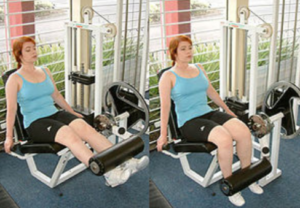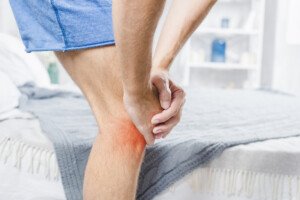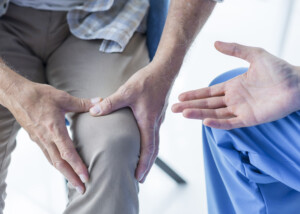An orthopedic surgeon has simple and smart solutions for men and women who have pain under their kneecap upon rising from a seated position.
There’s no problem while you’re sitting.
Everything feels fine as you work on the computer, watch TV, read or dine at your favorite restaurant.
But you dread that moment when you have to get up from your chair – because you know you’ll get pain under your kneecap.
This is not normal even if you’re not as young as you used to be.
Do not blame old age on this. A painful kneecap upon standing up from a chair can also affect younger people.
Cause of Pain Under Kneecap After Rising from a Chair or Bed
“The most common cause of this type of pain is malalignment of the kneecap, a condition which is most common in women,” says Barbara Bergin, MD, board certified orthopedic surgeon at and co-founder of Texas Orthopedics, Sports & Rehabilitation Associates.
“This is because the shape of our pelvis (for child bearing) causes our femur [thigh bone] to rotate, thereby resulting in lateral tracking of the kneecap.”
However, men as well can have a knee that hurts upon standing.
“Over time, this in turn results in abnormal wear of the articulate cartilage under the kneecap. That is a painful condition.
“Occasionally, thickened soft tissue under the kneecap can pinch between the kneecap and the end of the femur, much in the same way thickened tissue on the inside of your cheek can keep getting pinched between your teeth.”
5 Solutions to Pain Under the Kneecap Rising from Sitting
SLAM — for Women
Dr. Bergin urges women to take the SLAM approach: Sit Like A Man. Yes, that’s right. “This will help maintain the alignment of your kneecap.”
Now of course, you’re not going to feel at ease sitting like a man if you’re wearing a mini skirt.
But many women “sit like women” even when they’re wearing casual attire like long jeans, leggings and shorts.
Furthermore, the SLAM approach can be done even in more feminine clothes such as longer skirts and dress pants.
This doesn’t mean you must sit like a cowboy while wearing your power suit, but you can still masculinize your seated position somewhat without feeling that it’s inappropriate for your gender or clothes.
For instance, simply do not cross your legs. This is the biggest culprit.
You can keep your legs apart without sitting in what you might think is unattractive for a woman.
Sit with your legs apart, but they don’t have to be widely apart. In addition, while you’re at home or somewhere where you wouldn’t be self-conscious of your sitting posture, go SLAM!
Many women keep their legs crossed for sustained periods while alone, and this can be setting them up for pain beneath the kneecap.
The SLAM method may sound silly, but take an orthopedic surgeon’s advice and just try it.
Strengthen the Vastus Medialis
This is the middle muscle of the quadriceps group, the one that runs down the middle of your thigh.
A strong vastus medialis will help better support the kneecap (patella bone) and its surrounding structures.
It’s a safe bet that both men and women with pain under the kneecap triggered by getting out of a chair have weak quads. It’s an even safer bet that they don’t do quad strengthening exercises.
A very effective exercise is the leg extension (see image below). Do not lock out the knees at the top of the movement; keep a soft bend.

George Stepanek
Do not let the feet flop; keep them at a 90 degree angle to your shins so that your toes are pointing to the ceiling at the top of the movement.
Do 12 to 15 repetitions with light weight; you should not strain, though beginners will feel a big burn in their thighs.
Another muscle group to strengthen is the hip external rotators. The gym machine for this is the “seated hip abduction.” You can also strengthen these muscles at home.

Shutterstock/Comeback Images
Avoid Offending Activities
“Stop doing the activities which hurt,” says Dr. Bergin. “Let me say this again. Stop doing the activities which hurt!
“There is essentially no circumstance in which you can continue to squat and climb stairs, and get well. No squats for exercise and avoid stair climbing as a source of exercise.”
Knee Braces
“Occasionally you can try special knee braces which have a hole and a pad around the patella, which help to transiently push the kneecap where it’s supposed to go.”
Swollen Knee
“If your knee is swollen, you can take NSAIDS, or have knee injections of cortisone, if it’s appropriate for your situation,” says Dr. Bergin.
Finally, avoid sitting on your heels while gardening or doing any other task including yoga. This puts pressure on the kneecap.

Dr. Bergin is a general orthopedist, surgically and conservatively treating all manner of bone and joint conditions. She enjoys educating patients so they can emerge stronger than they were before their orthopedic injury or surgery.
 Lorra Garrick has been covering medical, fitness and cybersecurity topics for many years, having written thousands of articles for print magazines and websites, including as a ghostwriter. She’s also a former ACE-certified personal trainer.
Lorra Garrick has been covering medical, fitness and cybersecurity topics for many years, having written thousands of articles for print magazines and websites, including as a ghostwriter. She’s also a former ACE-certified personal trainer.
.









































